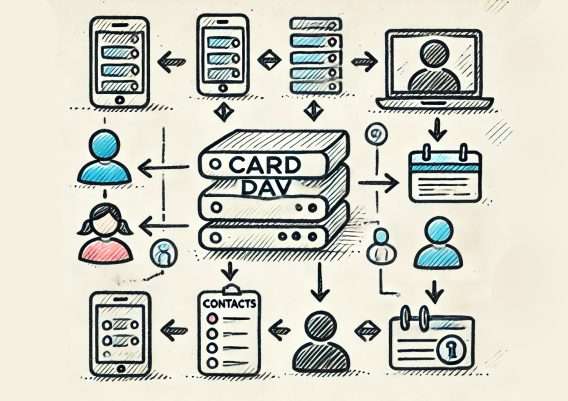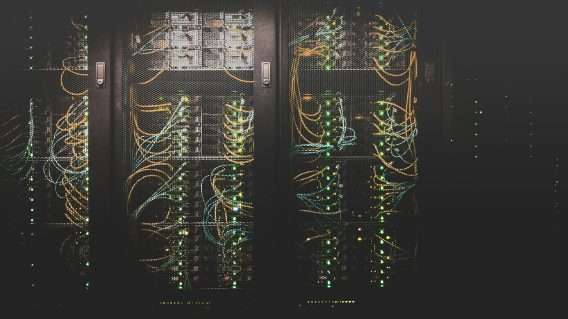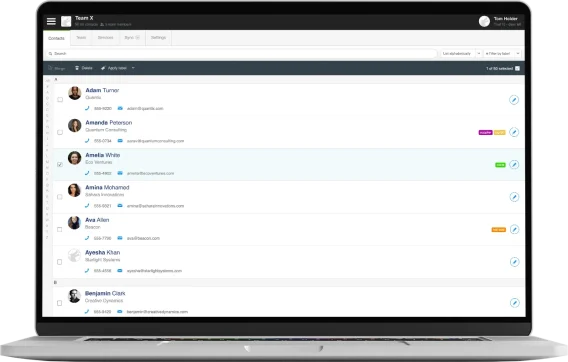Mastering CardDAV Server: The ultimate guide to Contact Synchronization

Introduction
Are you tired of juggling contact information across multiple devices, only to find outdated email addresses and phone numbers when you need them most? If so, it’s time to get acquainted with CardDAV – the unsung hero of contact synchronization. Think of it as a reliable assistant for your address book, ensuring your contacts are consistent and current across all your devices. While contact management might not be the most thrilling topic, it’s an essential part of our digital lives. From seamlessly connecting with clients to remembering your old friend’s new number, a well-managed contact list is the backbone of our interconnected world. In this article, we’ll dive into the world of CardDAV, exploring how it works and why it’s a powerful tool for keeping your contacts in order. We’ll also discuss the pros and cons of setting up your own CardDAV server versus using a contact management system that leverages the CardDAV protocol.
So, let’s get started and discover how CardDAV can bring some much-needed organization to your digital address book and simplify your contact management.
CardDAV: The Powerhouse Behind Seamless Contact Synchronization
• Was officially released in August 2011 as RFC 6352 by the Internet Engineering Task Force (IETF), making it a relatively young but rapidly adopted specification in the tech world.
• It’s an open source server protocol, meaning it’s not controlled by any single company, fostering widespread adoption and continuous improvement.
• It is built on top of WebDAV, leveraging existing web technologies like HTTP for efficient data transfer and storage.
• The protocol uses the vCard format (RFC 6350), a universal standard for storing contact information, ensuring broad compatibility across different systems.
• Major tech giants like Apple, Google, and Microsoft support CardDAV, highlighting its importance in the digital ecosystem.
• It allows real-time sync, ensuring that changes made on a device are instantly reflected across all connected devices.
• It supports fine-grained access control, making it suitable for both personal use and enterprise-level contact management.
• CardDAV is platform-agnostic, working seamlessly across different operating systems and devices.
• The protocol enables centralized storage of contacts on a server, allowing access from multiple devices and users.
• It supports server-side filtering and pagination, making it efficient even for managing large contact lists with thousands of entries.
• It works hand-in-hand with CalDAV, a similar protocol for calendar synchronization, providing a comprehensive solution for personal information management.
• CardDAV allows for self-hosting, giving users complete control over their contact data storage and privacy.
Share read-only contact lists across 100’s of devices
 14 DAY FREE TRIAL
14 DAY FREE TRIAL  NO CREDIT CARD REQUIRED
NO CREDIT CARD REQUIRED
How a CardDav server works

A CardDAV server acts as a central hub for contact management, working behind the scenes to keep your digital contacts synchronized across devices. CardDAV clients, such as email applications or addressbook software, communicate with the server to send and receive contact information updates. Here’s how it operates:
vCard Storage and Management
At its core, a CardDAV system uses vCards – digital contact cards that store essential details about your contacts, including names, phone numbers, email addresses, and profile pictures. These vCards are managed by a dedicated contacts server, which acts as the central repository for all your contact information.
Centralized Cloud Storage
The CardDAV system sets up a secure storage space in the cloud for your master contact database. This acts as a centralized repository for all your contact information, accessible from anywhere with the proper credentials.
Real-Time Synchronization
When you update a contact on any connected device, the CardDAV server immediately processes this change. It swiftly communicates the update to the central storage and then broadcasts the change to all your other connected devices, ensuring consistency across your entire ecosystem.
Cross-Platform Compatibility
A CardDAV server is designed to communicate with various devices and operating systems. This ensures your contacts are available whether you’re using Apple, Android, or any other compatible platform.
Access Control and Authentication
To ensure security CardDAV implemets robust measures like authentication methods to ensure only authorized devices and users can view or edit your contacts, protecting your valuable contact information.
Efficient Data Transfer
Instead of transmitting your entire contact list for every change, a CardDAV server only sends updates. This approach saves data and maintains speed, even when managing extensive contact lists.
By understanding these core functions, you can appreciate why a CardDAV server is such a powerful tool for maintaining your digital contact list. It effectively serves as a dedicated contact management system, ensuring your contacts remain consistent and up-to-date across all your devices.
Tip: If you’d like to know how to add a CardDAV account on your iphone see our guide on How to Organize Contacts on iPhone.
Benefits of using CardDav for Contact Management
CardDAV enhances contact management by providing a seamless, centralized system that keeps your contacts up-to-date across all your devices. When you use a CardDAV-enabled contact manager, your contact data is stored on a central server, which acts as the hub for syncing any changes or updates you make in real-time.
Beyond seamless syncing, CardDAV offers several key benefits:
| Benefit | Description |
| Seamless Sync | Changes made to contacts on one device are instantly synced across all connected devices, keeping information consistent and up-to-date. |
| Centralized Storage | Advanced data fields and custom tags allow contacts to be categorized and organized in a way that makes sense for the user, making it quick and easy to find the right contact. |
| Improved Organization | Advanced data fields and custom tags allow contacts to be categorized and organized in a way that makes sense for the user, making it quick and easy to find the right contact. |
| Enhanced Collaboration | Contact information can be easily shared with team members or family, ensuring everyone has access to the most current, consistent data and reducing miscommunication. |
| Cross-Platform Compatibility | As an open standard, CardDAV works across a wide array of devices and operating systems, allowing contacts to remain accessible regardless of the device being used. |
| Increased Security | Hosting contact data on a server of choice gives greater control over security and privacy, allowing implementation of custom security measures and access controls. |
| Open Source Nature | Being an open source protocol, CardDAV benefits from community support, transparency, and continuous improvement. |
| Widespread Adoption | CardDAV is supported by major tech companies like Apple, Google, and Microsoft, ensuring broad compatibility and robust ongoing development. |
| Focus on Contacts | Unlike more complex protocols, CardDAV is specifically designed for efficient contact management, providing an optimized user experience. |
Tip: Managing a business team? Rather than struggling with personal contact sharing methods, implement a professional shared contact list solution that gives your entire team secure access to contacts with customizable permissions.
Comparing CardDAV with Exchange ActiveSync
CardDAV is specifically designed for contact sync, while Exchange ActiveSync (EAS) handles a broader range of data types, including email, calendar, and tasks. This focus allows CardDAV to provide a more streamlined and optimized experience for managing contacts. In terms of compatibility, CardDAV has the advantage of being an open standard supported by a wide range of devices and platforms. EAS, on the other hand, is a proprietary protocol primarily used with Microsoft products and licensed third-party solutions, which can limit its accessibility.Another key difference is push support. EAS offers robust push capabilities, allowing for near-instant updates across devices. CardDAV, while supporting push, has more limited implementation compared to EAS.Despite these differences, both protocols use HTTP/HTTPS for transport and offer reliable sync capabilities. The choice between them often depends on the specific needs of the user or organization. For those primarily focused on contact management and interoperability, CardDAV is a strong choice. For Microsoft-centric environments or those requiring comprehensive sync of email, calendar, and tasks, EAS may be the preferred option.
| Primary Focus | Contact synchronization | Email, contacts, calendar, tasks synchronization |
| Compatibility | Wide range of devices and platforms | Primarily Microsoft products and licensed third-party solutions |
| Data Format | vCard | XML |
| Transport Protocol | HTTP/HTTPS | HTTP/HTTPS |
| Open Standard | Yes | No (proprietary) |
| Push Support | Limited | Yes |
| Adoption | Growing, supported by major tech companies | Widely used in corporate environments |
Integrating CardDAV with iOS devices, Email Services and Calendars
CardDAV’s seamless integration with email services and calendar applications is a key advantage that sets it apart from other sync protocols. This integration allows users to maintain a centralized, up-to-date address book that syncs effortlessly across their favorite email clients and productivity tools.
Email Client Integration
Most popular email clients, such as Gmail, Apple Mail, and Outlook, support CardDAV integration. This means you can easily sync your CardDAV contacts with your email application, ensuring that your address book is always current and accessible within your email environment.
Calendar Sync with CalDAV
CardDAV works hand-in-hand with CalDAV, a similar protocol designed for calendar synchronization. By using CardDAV and CalDAV together, you can keep both your contacts and calendar events in sync across multiple devices and applications. This powerful combination enhances productivity by providing a unified, always up-to-date view of your schedule and contacts.
Cross-Platform Compatibility
One of the key benefits of CardDAV’s integration capabilities is its cross-platform compatibility. Whether you’re using iOS, Android, or web-based applications, CardDAV ensures that your contacts remain synced and accessible. This flexibility allows you to choose the tools that work best for you without being tied to a single ecosystem.
Streamlined Setup Process
Setting up CardDAV integration with your email and calendar applications is a straightforward process. Many apps offer built-in support for CardDAV, making it easy to configure your account and start syncing your contacts. For apps that don’t have native CardDAV support, there are often third-party plugins or extensions available to enable seamless integration.
Google’s CardDAV Implementation and Authentication
Google, one of the world’s leading tech companies, has embraced CardDAV as a protocol for syncing contacts across its ecosystem. However, Google’s implementation of CardDAV comes with some unique characteristics that are worth exploring.
OAuth 2.0 Authentication
One of the most notable aspects of Google’s CardDAV implementation is its strong focus on security. Google exclusively relies on OAuth 2.0 for authentication for the users Google account, ensuring that only authorized applications and users can access and sync contact data. This adherence to modern authentication standards helps protect user privacy and prevents unauthorized access to sensitive information.
Supported HTTP Methods
While Google’s CardDAV implementation supports core HTTP methods like GET, PUT, DELETE, OPTIONS, and PROPFIND, it doesn’t support some less common methods such as LOCK, UNLOCK, COPY, MOVE, or MKCOL. This streamlined approach allows Google to focus on the essential functionality required for efficient contact synchronization.
Limitations and Peculiarities
It’s important to note that Google’s CardDAV implementation doesn’t support arbitrary (user-defined) WebDAV properties or WebDAV Access Control (RFC 3744). Additionally, while it supports the REPORT method, not all defined reports are implemented.
Discovering CardDAV URLs
Google follows the standard outlined in RFC 6764 for bootstrapping CardDAV URLs. Client applications must use the well-known URI https://www.googleapis.com/.well-known/carddav to discover the address book and contact resource URIs. This ensures a consistent and reliable way for clients to connect to Google’s CardDAV server.
Implications for Developers
For developers building applications that integrate with Google’s CardDAV server, it’s crucial to understand these specific implementation details. By designing their applications to work seamlessly with Google’s OAuth 2.0 authentication and supported HTTP methods, developers can create robust and secure contact synchronization solutions.Google’s adoption of CardDAV, with its focus on security and streamlined functionality, demonstrates the protocol’s real-world value and its ability to be tailored to the needs of major tech platforms. As more companies and developers embrace CardDAV, understanding the nuances of different implementations will be key to creating effective and interoperable contact management solutions.
Setting Up Your Own CardDAV Server vs Using a Contact Management System
Pros and Cons of Hosting Your Own Server
| Advantages | Challenges |
| Complete Control – You have full control over your data and server configuration. | Technical Expertise – Requires knowledge of server administration and networking. |
| Customization – You can tailor the setup to your specific needs. | Maintenance – You’re responsible for updates, backups, and troubleshooting. |
| Privacy – Your data remains on your own infrastructure. | Reliability – Depends on your infrastructure and internet connection. |
| Cost-effective – potentially low-cost, especially if you have existing hardware. | Scalability – May require additional resources as your needs grow. |
Pros and Cons of Using a Contact Management System built on CardDAV
| Advantages | Challenges |
| Ease of Use – Typically offers a user-friendly interface for managing contacts. | Less Control – You’re dependent on the service provider’s infrastructure and policies. |
| Automatic Updates – The service provider handles software updates and maintenance. | Potential Privacy Concerns – Your data is stored on third-party servers. |
| Reliability – Often provides better uptime and redundancy than self-hosted solutions. | Costs – May involve ongoing subscription fees, especially for business use. |
| Additional Features – May offer advanced functionalities beyond basic CardDAV capabilities. | Vendor Lock-in – Migrating to another system can be challenging. |
| Cross-Platform Support – Usually works seamlessly across various devices and operating systems. |

Choosing between these options depends on your technical skills, resources, and specific needs. For individuals or small teams with technical expertise, setting up a CardDAV server can be a cost-effective and privacy-focused solution. However, for those seeking a more hands-off approach with additional features and support, a contact management system that utilizes the CardDAV protocol might be the better choice.
Tip: Contactzilla offers powerful contact management software designed specifically for small businesses. Learn more about how Contactzilla can streamline your contact management without the technical overhead of self-hosting
Options for setting up your own CardDav Server
While there are several CardDAV server solutions available, let’s focus on three popular options that offer a balance of features, ease of use, and active development:
Radicale
- A lightweight, open-source CalDAV and CardDAV server
- Written in Python, making it cross-platform compatible
- Known for its simplicity and low administrative overhead
- Ideal for personal use or small teams
- Supports multiple users and shared address books
Baïkal
- Based on the sabre/dav library, which is widely used in the industry
- Offers a user-friendly web interface for managing users, contact lists, and calendars
- Supports CalDAV, CardDAV, and WebDAV
- Can be easily deployed using Docker
- Suitable for both personal and small business use
Xandikos
- A lightweight yet feature complete CadDAV server
- Unique in that it backs onto a Github repository, allowing version control of your contacts
- Supports various clients, including Evolution, DAVdroid, and Apple iOS
- Can be run directly on Linux or within Docker/Kubernetes
- Ideal for users who appreciate the benefits of Git-based version control
Each of these options has its strengths, and the best choice depends on your specific needs, technical expertise, and scale of deployment. For personal use or small teams, any of these could be suitable, with Radicale being particularly easy to set up, Baïkal offering a nice balance of features and usability, and Xandikos providing unique version control capabilities. Remember that setting up your own server requires ongoing maintenance, security updates, and potentially complex configuration. In the next section, we’ll explore how using a contact management system built on CardDAV can provide similar benefits with less administrative overhead.
The Power of CardDAV-Enabled Contact Management Systems

While setting up your own server offers control and customization, it requires technical expertise and ongoing maintenance. For many individuals and businesses, a more user-friendly and efficient solution is to use a contact management system that leverages the CardDAV protocol. These systems combine the power of Card DAV with additional features and a user-friendly interface. One such system that stands out in this space is Contactzilla. Let’s explore the benefits of using a CardDAV-enabled contact management system like Contactzilla:
| Benefit | Description |
| Customizable Data Fields | Contactzilla allows you to add custom fields to contacts, enabling you to tailor contact information to your organization’s specific needs. |
| Easy Contact Import | Contacts can be effortlessly imported from various sources, including Microsoft Office, Gmail, and CSV files, making it simple to transition to Contactzilla |
| User-Friendly Interface | Contactzilla offers an intuitive, easy-to-use interface designed specifically for small businesses, eliminating the need for technical expertise required to set up and maintain your own server. |
| Automatic Updates and Maintenance | Unlike self-hosted solutions, Contactzilla handles all updates and maintenance, ensuring you always have the latest features and security patches without any effort on your part. |
| Enhanced Collaboration Features | Contactzilla provides robust team collaboration tools that go beyond basic CardDAV functionality, making it easier for teams to work together on contact management. |
| Cross-Platform Compatibility | While CardDAV is generally cross-platform, Contactzilla ensures seamless integration across various devices and operating systems. |
| Granular Access Control and specification | Our platform allows for fine-grained access control, enabling you to share specific contacts or entire address books with selected individuals or groups and assign read or write access as you see fit. |
| Data Redundancy and Backup | Your contacts are automatically backed up and protected against data loss, a feature that would require additional setup and maintenance on a self-hosted server. |
| Advanced Search and Filtering | Contactzilla provides powerful search and filtering capabilities that may be more advanced than what’s available in basic CardDAV implementations. |
| Professional Support | Unlike self-hosted solutions, Contactzilla offers dedicated customer support to help you resolve any issues quickly and efficiently. |
These benefits make Contactzilla an attractive option for those seeking a robust, flexible, and user-friendly app approach to contact management without the technical overhead of managing their own server.
Conclusion
So, there you have it – the ins and outs of CardDAV and contact management. Whether you’re a tech wizard itching to set up your own server or someone prefers a more streamlined approach, the CardDav protocol can not be beat when it comes to contacts. At the end of the day, it’s all about keeping your contacts organized and your life a little less chaotic. If you have the technical know-how and enjoy hands-on control, setting up your own server could be a rewarding experience. But if you’re like many of us and prefer to focus on using your contacts rather than managing the system behind them, a solution like Contactzilla might be just what you need.
Tip: Looking for more ways to keep your contacts organized and maximize your business relationships? Check out our guide on effective contact organization techniques to take your contact management to the next level.
Frequently Asked Questions
What is CardDAV on iPhone
CardDAV on iPhone is a protocol that allows you to sync your contacts across multiple devices and services. It keeps your contacts up-to-date and accessible on your iPhone, even if you make changes on another device or in a web-based contact manager that supports CardDAV.
What are the key differences between CardDAV and ActiveSync?
CardDAV and ActiveSync are protocols for syncing contact information, with key differences:
- CardDAV is open-source; ActiveSync is proprietary.
- CardDAV focuses on contacts; ActiveSync syncs emails, calendars, and tasks too.
- CardDAV has wider platform support.
- ActiveSync offers push notifications; CardDAV typically uses periodic syncing.
What is the difference between CardDAV and WebDAV
WebDAV is a general protocol for creating, modifying, and moving documents on a server. CardDAV, built on WebDAV, is specifically designed for contact management. While WebDAV can handle various file types, CardDAV focuses on synchronizing and sharing contact data using the vCard format.
How does CardDAV integrate with popular email services like Gmail?
CardDAV integrates with popular email services like Gmail through built-in support or third-party apps. For Gmail:
- Use Google’s CardDAV API for direct integration.
- Set up CardDAV in email clients like Thunderbird or Apple Mail.
- Use mobile apps that support CardDAV synchronization with Gmail.
- Enable two-way sync between Gmail contacts and CardDAV-compatible devices.
How has the CardDAV protocol evolved since its inception?
Since its inception RFC 6352 in 2011, CardDAV has evolved to support higher-resolution contact images, reduce data consumption, and gain widespread adoption across platforms like iOS and Gmail. It has become a standard for contact syncing, replacing older protocols like ActiveSync in many services.
What are the security features of CardDav?
CardDAV ensures security through HTTPS encryption for data in transit, requiring authentication (e.g., OAuth 2.0 Authorization framework – RFC 6749) to access contact data It supports client-side encryption for additional security, making it suitable for both self-hosted and cloud-based implementations.
How do you set up a CardDav Server?
To set up a CardDAV server:
- Choose a CardDAV server software (e.g., Radicale, Baïkal).
- Install the software on your server.
- Configure the server settings and user authentication.
- Set up SSL encryption for security.
- Create user accounts and address books.
- Configure your devices to connect to the server.